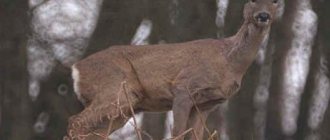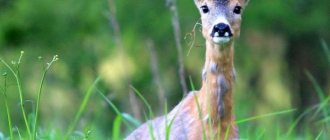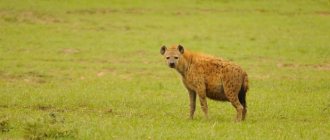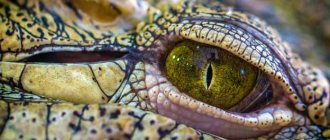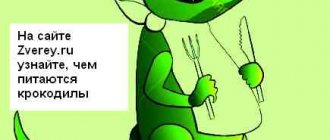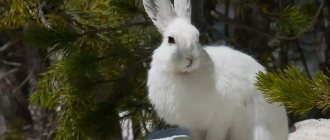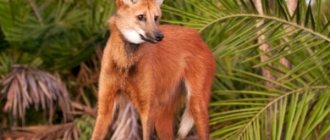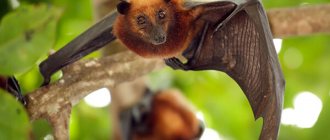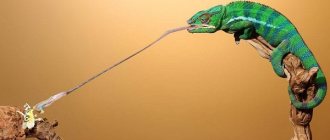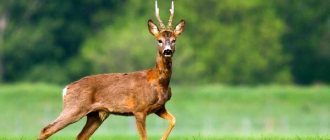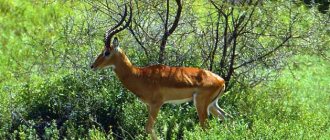- December 17, 2019
- Hunting
- Dina Nigmatulina
The roe deer is a cloven-hoofed animal of the deer family and belongs to the class of mammals. The Russian name is wild goat. The front part of the body is 5 cm lower than the raised back part. The body shape can be seen in detail in the photo of the roe deer. The animal differs from its relatives in its small size and slender build.
Appearance of a European roe deer
The body of the European roe deer is short - 108-126 centimeters, and the height at the withers reaches 66-81 centimeters. Males weigh 22-32 kilograms. Roe deer living in the northern regions are larger in size. The length of the tail is 3 centimeters, it is almost invisible, it hides in the fur.
European roe deer (Capreоlus capreоlus).
The head of the European roe deer is short, becoming narrower towards the nose, and near the eyes it is quite wide. The ears are pointed, oval in shape, their length is 12-14 centimeters. Their eyes are large with slanted pupils.
The legs of European roe deer are thin and long, thanks to which they can run quickly. The hearing and sense of smell of these animals are acute.
Wool varies depending on the season, area and age of the animals. The color of small roe deer is reddish-brown with white spots.
The color of adult roe deer can be dark red in summer, and in winter it becomes black and white. The winter coat consists of thick hair with a large number of air cavities that hold air; the length of such hair is 5-5.5 centimeters.
Horns adorn only the heads of males; most often they do not exceed 30 centimeters in length. Each horn has 3 processes: the middle horn is directed forward, and the other two are directed upward. Horns begin to grow as early as 4 months, and are fully formed only by 3 years.
Description
The roe deer is a small deer with an elegant body structure. The body is short, in the back it is larger and set slightly higher than in the front. The head of a roe deer is small. The neck of females is thinner and longer than that of males.
This animal has incredibly beautiful eyes. His ears are covered with fur on both the outside and the inside. The legs are long, the front legs are slightly shorter than the hind legs, with beautiful sharp black hooves. This structure allows the animal to run quickly. The male is distinguished by the presence of small horns with processes and tubercles. This is clearly visible in the photo of a male roe deer.
In autumn, the animal sheds its antlers and becomes like a female. Roe deer is an animal that lacks an external tail. It is so small that it is completely hidden under fur.
Range of European roe deer
These animals live in Europe, including the Scandinavian Peninsula; they also live in Russia, Transcaucasia, Ciscaucasia and part of Asia.
In Israel and Lebanon, European roe deer have become extinct, and they have also been destroyed on the island of Sicily. These animals can be found in Albania, Austria, Belarus, Italy, Georgia, Lithuania, Poland, the Netherlands, Monaco, France, Romania, the Czech Republic, Sweden and other countries.
The European roe deer is a medium-sized, graceful deer.
On the northeastern border (Ural Range), this species borders on Siberian roe deer, as a result of which there are transitional forms in these places.
Natural enemies
Roe deer are hunted by most medium and large predatory animals, but lynxes and wolves pose a particular danger to the artiodactyl. Newborn roe deer calves are quite often and actively destroyed by foxes, raccoon dogs, badgers and martens, golden eagles and wild boars. Wolf predation increases in snowy winters, when roe deer's movement is difficult.
Predators are capable of attacking not only very weakened, but also completely healthy roe deer. In years characterized by heavy snowfalls, a significant number of roe deer, especially young and poorly nourished animals, die from hunger or basic exhaustion.
Return to content
Lifestyle of European roe deer
European roe deer are active in the morning and evening hours. On hot days, roe deer feed less often, and in winter they become voracious.
The social life of European roe deer depends on the time of year.
In summer, most roe deer lead a solitary lifestyle, and in winter they group in herds. From March to August, roe deer are more aggressive and exhibit territorial behavior. Males occupy a territory from 2 to 200 hectares.
Males regularly walk around their areas and mark them. They try not to violate boundaries, but young individuals can act as aggressors. Conflicts between them rarely occur; most often it ends in a show of force. Females with babies live in the male’s area, and he aggressively drives out the one-year-olds.
Females are hornless. Occasionally there are females with horns.
In October, the aggressiveness of males becomes significantly lower; they shed their antlers and stop marking the boundaries of their territories. Winter families begin to form - young animals join females with babies. Members of the group stay together all winter; the number of individuals in such groups is 40-90. European roe deer, unlike their Siberian counterparts, do not make winter migrations.
Winter colonies of European roe deer last until March or April, and then begin to disintegrate.
When the roe deer is calm, it moves at a trot or walk, and in times of danger it runs, making jumps about 7 meters long. The speed of an adult roe deer is approximately 60 kilometers per hour.
Nursing females move in small steps, but they often stop and listen to what is happening around them. Roe deer can swim well and quickly. They do not tolerate high snow cover well and try to move along animal trails. Roe deer slide on the icy snow crust, so it is dangerous for them.
European roe deer feed on more than 900 species of different plants, preferring young shoots. They feed 5-11 times per day.
Newborn roe deer have a spotted coloration, which allows them to camouflage among summer vegetation.
Social structure and reproduction
Photo: Siberian roe deer calf
The mating season for animals begins in mid-July and lasts one and a half to two months. Males are constantly looking for females; they eat practically nothing during this period. Females who have reached the age of two are considered sexually mature. If there are several contenders for the right to enter into mating relations with females, males may fight with each other.
There is also a manifestation of aggressiveness of males towards females. In one mating season, a male is able to fertilize up to 5-7 females. Female roe deer are also not distinguished by the formation of established connections. Although sometimes they can mate for several years in a row with the male they like best.
Latent pregnancy is observed in Siberian artiodactyls. That is, the resulting embryo stops growth and development for up to 3-4 months. If mating occurs in the fall, there is no latent period of pregnancy. As the embryo begins to grow, the female becomes more careful and careful. She is not characterized by sharp, dangerous jumps or too fast running. The gestation period is milked from 250 to 320 days. From one to three babies are born.
Roe deer cubs are very vulnerable and helpless. The female hides them in reliable shelters for several months.
The spots on the back help camouflage in thickets of vegetation. The mother is not far away, but prefers to feed and rest not with the babies, so as not to attract attention to them. The female maintains contact with the offspring until the emergence of a new generation.
Siberian roe deer have high fertility. With the onset of each new season, more than 96% of sexually mature female individuals of the species give birth. Despite high fertility, natural growth does not increase at a rapid pace. Among this species of ungulates, there is a low survival rate of cubs.
Reproduction of European roe deer
Roe deer are the most prolific in their family. Adult females give birth to 2 babies annually, which they feed with milk for 6-8 months. Already at the age of 2 years, European roe deer can have offspring. And old females can give birth to 3 or even 4 babies.
European roe deer have 2 rutting periods - the main one in August, and an additional one in December. Females who for some reason remained unfertilized mate for the second time; their pregnancy is reduced to 5 months.
During the mating season, roe deer do not form close pairs. After fertilization, the male leaves the female and looks for a new one. Dominant males fertilize most females.
Reproduction of roe deer depends on living conditions and the amount of food; under favorable conditions, females give birth to two babies, but young individuals give birth to one cub.
European roe deer moult twice a year.
Calves appear in the summer, when there is quite a lot of succulent food around. Roe deer milk is very nutritious; it contains a large amount of fats, proteins, sugar and other elements useful for growth. The mother feeds the babies with milk for a long time, and if there is only one baby in the litter, he receives abundant nutrition, and therefore it can be difficult to distinguish a 5-month-old from a six-month-old.
The calves spend their first winter already well grown and they do not die too often, but in severe winters the situation is different; mortality among young animals is high, especially among those who have not had time to gain weight.
What does the Siberian roe deer eat?
Photo: Male Siberian roe deer
Siberian roe deer are herbivores. However, it cannot be said that they feed only on grass. Animals can eat mushrooms, berries, young shoots, and leaves. In early spring, they eat the budding buds on trees. They prefer juicy, fresh greens. They can feed on dry vegetation and cereals when there is a lack of food.
In order for the body to receive the necessary minerals, roe deer eat salt licks or look for water sources that are enriched with minerals for watering. During the period of bearing and feeding cubs, the need for minerals increases several times.
The most difficult period for the Siberian roe deer is the end of winter. It is at this time that they feel an acute lack of mineral-rich food, as well as fluid. When bodies of water freeze, they can eat snow to replenish the body's fluid needs. In winter, in the absence of food, they can eat coniferous trees.
The digestive system of artiodactyls has a small stomach. Because of this, roe deer eat little. However, an active metabolism requires frequent food intake. During the day, one adult individual has at least 7-10 meals. The daily food intake for one individual is determined by its body weight and is approximately 2-2.5 kilograms of green vegetation. During the cold season, the daily amount of food decreases, as does its calorie content.
In conditions of food shortages, fierce competition grows between other representatives of ungulates and Siberian roe deer. In winter, in the absence of a food source, roe deer dig up snow with their hooves, digging out dry vegetation. They are able to get their food from under layers of snow, the thickness of which reaches half a meter.
Interesting facts about European roe deer
• For unknown reasons, males sometimes grow abnormal horns - without branches. Such males are very dangerous for their relatives, since during ritual fights, their horns do not mesh with the horns of the enemy, and can pierce him through.
• Sometimes European roe deer are called wild goats, but they have nothing in common with goats.
Compared to other ungulates, European roe deer have better adapted to changes in landscapes by humans.
How to determine the age of a roe deer by its antlers
The absence of shoots indicates that the animal has not reached one year. But some one-year-old males have them. In adults, the absence of processes is extremely rare.
It is quite difficult to correctly determine the age of an animal. To do this, the roe deer must be brought closer. A more accurate method is by examining the base of the horns. If they are set low at the base of the skull, then the animal is old. Every year, as the antlers are shed, the height of the base decreases.
In one-year-old male roe deer, the processes are very rarely directed backwards. This is typical for older individuals.
Older males shed their antlers earlier than younger ones. This feature can also be used to determine the age of a roe deer. New antlers grow about three weeks earlier in mature individuals. They are formed by the end of February, in younger animals - by mid-March, and in yearlings they only begin to develop in the first month of spring. You can clearly see the antlers of a young male roe deer in the photo below.
Wintering conditions and the physical condition of the animal should also be taken into account. Due to these indicators, a roe deer can shed its antlers several weeks earlier. In this case, the results of determining the age of the individual will be incorrect.
Number of European roe deer
Today, this species is classified as a low-risk animal. In recent decades, conservation measures have been actively carried out, thanks to which European roe deer have become quite common. The number of the species as a whole tends to increase.
The highest numbers of roe deer are observed in Central Europe, where the population is estimated at about 15 million individuals, and in the 80s the number did not exceed 7.5 million. However, the Syrian population is rare and needs protection.
The European roe deer is in the Red Book of the Tula and Saratov regions.
The number of roe deer is declining due to overhunting. But in general, due to their high fertility, European roe deer, in the presence of suitable habitats, restore their numbers well.
Lifestyle
In summer, roe deer are active in the morning, evening and night. In winter, they are predominantly diurnal, but can be active around the clock.
In the warm season, roe deer live alone, except for females, accompanied by yearling calves. During the mating season, temporary pairs of animals appear. In October, the animals, previously living alone, unite into small herds, the basis of which are family groups, and remain in such herds until spring. Herds often unite into large herds of up to hundreds of individuals. It happens that in these herds there are from several to several dozen males, which in the winter peacefully coexist next to each other, while in the summer (while they live alone) they are exclusively aggressive towards other males.
In winter, large groups of roe deer most often form in feeding areas in order to detect danger in a timely manner. The roe deer is a cautious animal, so the more individuals there are in the herd, the sooner one of them will notice the predator. The sight of a running individual immediately provokes other roe deer to flee after it. The composition of large herds is not constant - when fleeing from danger, such a herd easily breaks up into family groups and then forms in a different composition.
Photo credit: Gouwenaar, CC BY-SA 3.0
INTERESTING FACTS. DID YOU KNOW THAT...
- During the mating game, the female roe deer “runs away” from the male, running in circles called “enchanted” circles.
- Roe deer often become prey for lynx. The predator, having killed the roe deer, begins the meal, first separating the head from the body of the carcass. The main enemy of roe deer is the wolf. Far Eastern roe deer also often become prey for harza.
- The last roe deer in England and Wales were killed by hunters in 1730. In the 90s of the 18th century, animals were brought here from Scotland, which soon multiplied and laid the foundation for a new population.
Bibliography
- V.E. Sokolov. Five-language dictionary of animal names. Mammals. Latin-Russian-English-German-French. – M.: Rus.yaz., 1984. , p. 352
- A.A. Danilkin. Mammals of Russia and adjacent territories. Deer (Cervidae). – M., GEOS, 1999, p. 552 pp.
- V.A. Minoransky, O.P. Dobrovolsky. Past and present of hunting mammals of the Lower Don. – Rostov n/d: Foundation, 2013., p. 218
- AND I. Pavlinov. Nature of Russia: animal life. Mammals (part 1). - M., LLC "", 1999, p. 608
- YES. Plakhina, E.Yu. Zvychaynaya, M.V. Kholodova, A.A. Danilkin. Identification of hybrids of European (capreolus capreolus l.) and Siberian (c. Pygargus pall.) Roe deer based on microsatellite analysis. M., Genetics, 2014, volume 50, no. 7, p. 862-867
- G.A. Novikov, E.K. Timofeeva. Urbanization of natural landscapes and synanthropization of forest artiodactyls // Ungulate fauna of the USSR. – M., Nauka, 1980, p. 38-39
- E.K. Timofeeva. Roe. – L., Leningrad University Publishing House, 1985, p. 224
- Life of animals. In 7 volumes / Volume 7. Mammals. / Ed. V.E. Sokolova. – M., “Enlightenment”, 1989, p. 558
- https://www.ohotcontrol.ru/resource/Resources_2008-2013/Roe.pdf
- https://www.drivenn.ru/journal/novosti/shtrafy-za-sbitoe-zhivotnoe-vyrosli-v-dva-raza-id28103
Author of the article: Oleg Pavlovich Dobrovolsky, zoologist, candidate of biological sciences
Did you like the article? Share with your friends:
CHARACTERISTIC FEATURES OF ROE DEER. DESCRIPTION OF THE ANIMAL
Horns: In the second year of life, the male grows horns with three branches. In May, animals get rid of rags of dead skin on their horns by scratching them on trees.
Summer coat: bright red, gray on the muzzle, black stripes stretch from the nose to the corners of the lips. Summer wool grows on roe deer in the spring, and in September-October it is replaced by winter wool.
Winter coat: Dull greyish, except for the light belly, thicker than the summer coat. Some adult animals have white spots on their throats.
— Habitat of roe deer
WHERE IS IT FOUND?
Roe deer is found in Europe, in temperate climates and in Asia to the Far East and Korea.
PROTECTION AND PRESERVATION
The number of roe deer has increased noticeably compared to the past. Favorable conditions for this were created by the development of agriculture. Previously, the number of roe deer was regulated by predators; today this is done by hunters.
Lifestyle and nutrition
Roe deer feed in the evening and at dawn. Day and night they rest, hiding in the bushes. In winter they are active around the clock. Unlike other representatives of the deer family, descriptions of roe deer indicate that these animals prefer solitude and gather in herds of 4-20 animals only when necessary - usually in winter for migration. Returning to summer pastures, their herds disintegrate.
The diet of roe deer consists of herbs, acorns, nuts, mushrooms, shoots of shrubs, and woody shoots. They can feed on leafy branches of raspberries, willows, hazels, birches, oaks, maples, and apples.
Attention! These little deer love milk mushrooms, honey mushrooms, rowan berries, strawberries and other berries.
In winter, they migrate to the forest, where they are forced to make do with moss, dry leaves and grasses, lichens, pine needles and bark. In order to search for food, they visit adjacent agricultural fields, picking up abandoned root crops and corn.
The roe deer rut occurs in July-November, sometimes lasting until December. Males are polygamous, forming harems of 2-3 females. Pregnancy in females lasts 6-9 months. This time period is explained by the ability of a fertilized egg to remain latent for several months. A litter consists of 1-3 cubs, which are born in May-June.
The first days the newborn young hide - they lie alone in the grass, curled up. The females go around the cubs one by one to feed them, and after a week they accompany the mother, keeping up with her. From 3 weeks of age, in addition to milk, they also begin to eat grass. While the cubs are small, they are tasty prey for foxes, stray dogs, jackals, golden eagles, and harza. Most young roe deer die in the first year of life.
Observations of roe deer and descriptions of their way of life indicate that humans are their main enemy today. Its activities not only contribute to the reduction of habitat for wild animals, but also lead to a reduction in the population of roe deer as a result of their death under the wheels of cars or as hunting trophies.
Murmansk region
Status: IV category. Species of uncertain status.
Spreading
The northern border of the roe deer range in the Murmansk region runs along the line, the river. Note - Chunatundra - Kandalaksha Bay. To the north, roe deer were observed in the Pasvik nature reserve.
Number
In the Murmansk region (the northernmost limit of the species' distribution), roe deer were first recorded in 1968. Later, from 1970 to 1999, visits were observed quite regularly every 3-5 years. Usually single animals are found, but sometimes small groups of up to 4-6 animals are recorded.
Source: Red Book of the Murmansk Region. Ed. Asming S.V., Berlina N.G., Belkina O.A., Bianki V.V., Bobrov A.A., Boyko N.S., Borovichev E.A., Vorobyova E.G. (2014)
Novgorod region
Status: III category. Rare view.
Spreading
In the second half of the 19th – early 20th centuries it was quite widespread. Currently inhabits the western part of the region (Batetsky, Volotovsky, Soletsky, Shimsky, Starorussky, Kholmsky districts), noted in the Novgorod, Parfinsky, Poddorsky, Demyansky districts, found periodically in the Chudovsky, Marevsky districts or visiting the Valdai region.
Number
In conditions of existence at the limit of the range, a decreasing type of population dynamics is characteristic.
Source: Red Book of the Novgorod Region. Ed. Yu.E. Vetkin, D.V. Geltman, E.M. Litvinova, G.Yu. Konechnaya, A.L. Mishchenko (2015) St. Petersburg, Deaton publishing house
